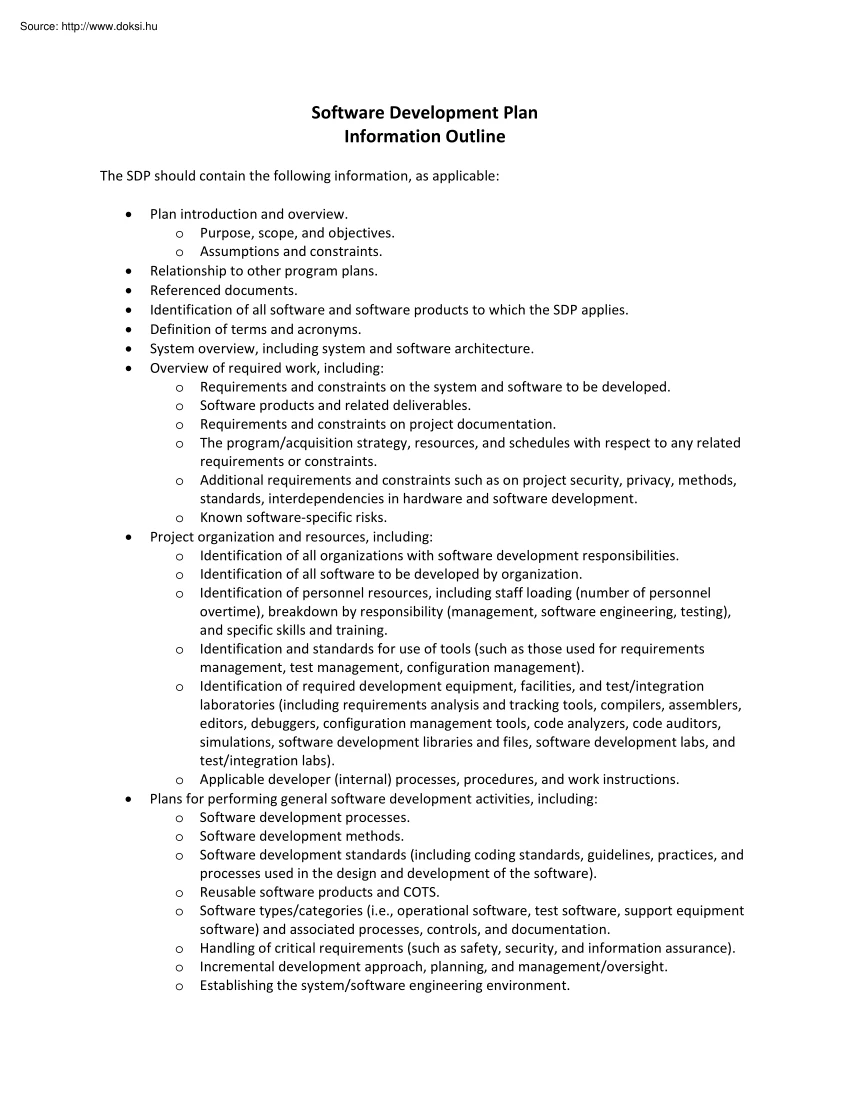Datasheet
Year, pagecount:2012, 2 page(s)
Language:English
Downloads:15
Uploaded:November 10, 2012
Size:66 KB
Institution:
-
Comments:
Attachment:-
Download in PDF:Please log in!
Comments
No comments yet. You can be the first!Most popular documents in this category
Content extract
Software Development Plan Information Outline The SDP should contain the following information, as applicable: • • • • • • • • • Plan introduction and overview. o Purpose, scope, and objectives. o Assumptions and constraints. Relationship to other program plans. Referenced documents. Identification of all software and software products to which the SDP applies. Definition of terms and acronyms. System overview, including system and software architecture. Overview of required work, including: o Requirements and constraints on the system and software to be developed. o Software products and related deliverables. o Requirements and constraints on project documentation. o The program/acquisition strategy, resources, and schedules with respect to any related requirements or constraints. o Additional requirements and constraints such as on project security, privacy, methods, standards, interdependencies in hardware and software development. o Known software-specific
risks. Project organization and resources, including: o Identification of all organizations with software development responsibilities. o Identification of all software to be developed by organization. o Identification of personnel resources, including staff loading (number of personnel overtime), breakdown by responsibility (management, software engineering, testing), and specific skills and training. o Identification and standards for use of tools (such as those used for requirements management, test management, configuration management). o Identification of required development equipment, facilities, and test/integration laboratories (including requirements analysis and tracking tools, compilers, assemblers, editors, debuggers, configuration management tools, code analyzers, code auditors, simulations, software development libraries and files, software development labs, and test/integration labs). o Applicable developer (internal) processes, procedures, and work instructions. Plans
for performing general software development activities, including: o Software development processes. o Software development methods. o Software development standards (including coding standards, guidelines, practices, and processes used in the design and development of the software). o Reusable software products and COTS. o Software types/categories (i.e, operational software, test software, support equipment software) and associated processes, controls, and documentation. o Handling of critical requirements (such as safety, security, and information assurance). o Incremental development approach, planning, and management/oversight. o Establishing the system/software engineering environment. • • o Computer resources utilization and reserve capacity/growth management. Software-related development processes, including: o Overall development methodology. o Prototyping and simulations. o System requirements analysis and design, including requirements definition and allocation
from the system level to the software level. o Software requirements analysis. o Software preliminary and detailed design. o Software unit integration and testing. o Software component integration and testing. o CSCI qualification testing. o CSCI/HWCI integration and testing. o System qualification testing. o Determination of fitness for intended use. o Other developmental testing (such as flight testing). Supporting processes and information, including: o Software risk management. o Approach to requirements traceability. o Software documentation, sufficient to capture and maintain all relevant design information. o Approach for evaluating, selecting, and integrating COTS and reused software. o Approach to designing for reuse. o Open source software approach including a description of the code, its specific origin, how it will be controlled, how it will be tested or analyzed for vulnerabilities, what vulnerabilities have been identified and overcome, and why such code is not a risk to
the program. o Prototyping and simulations. o Software configuration management, including configuration baselines, audits, problem identification/reporting/tracking/disposition, and patch definition and control. o Software quality assurance, including software product evaluation. o Technical reviews, audits (including entry/exit criteria), and other meetings. o Approach for detailed tracking of all software builds and all related tasks and activities, such as unit code, test, and integration, including allocation of specific software requirements to identified block or builds as well as the process to ensure consistency and integration of software schedules with the program IMP and IMS. o Status assessment and reporting (EVM, software metrics definition and use, technical performance measures). o Approach for problem tracking, reporting, and corrective action. o Approach for managing reserve computing capacity and growth, including margin allocation and budgeting, reserve capacity and
growth management and monitoring. o Approach for conducting information assurance and vulnerability analyses, detection, and prevention techniques throughout the software design and development lifecycle, including for COTS, reused, or modified products. o Supplier/subcontractor management, including flowdown of processes to suppliers/subcontractors, including the specific relationships of subcontractor SDPs. o Process improvement activities. o Support/sustainment approach/processes
risks. Project organization and resources, including: o Identification of all organizations with software development responsibilities. o Identification of all software to be developed by organization. o Identification of personnel resources, including staff loading (number of personnel overtime), breakdown by responsibility (management, software engineering, testing), and specific skills and training. o Identification and standards for use of tools (such as those used for requirements management, test management, configuration management). o Identification of required development equipment, facilities, and test/integration laboratories (including requirements analysis and tracking tools, compilers, assemblers, editors, debuggers, configuration management tools, code analyzers, code auditors, simulations, software development libraries and files, software development labs, and test/integration labs). o Applicable developer (internal) processes, procedures, and work instructions. Plans
for performing general software development activities, including: o Software development processes. o Software development methods. o Software development standards (including coding standards, guidelines, practices, and processes used in the design and development of the software). o Reusable software products and COTS. o Software types/categories (i.e, operational software, test software, support equipment software) and associated processes, controls, and documentation. o Handling of critical requirements (such as safety, security, and information assurance). o Incremental development approach, planning, and management/oversight. o Establishing the system/software engineering environment. • • o Computer resources utilization and reserve capacity/growth management. Software-related development processes, including: o Overall development methodology. o Prototyping and simulations. o System requirements analysis and design, including requirements definition and allocation
from the system level to the software level. o Software requirements analysis. o Software preliminary and detailed design. o Software unit integration and testing. o Software component integration and testing. o CSCI qualification testing. o CSCI/HWCI integration and testing. o System qualification testing. o Determination of fitness for intended use. o Other developmental testing (such as flight testing). Supporting processes and information, including: o Software risk management. o Approach to requirements traceability. o Software documentation, sufficient to capture and maintain all relevant design information. o Approach for evaluating, selecting, and integrating COTS and reused software. o Approach to designing for reuse. o Open source software approach including a description of the code, its specific origin, how it will be controlled, how it will be tested or analyzed for vulnerabilities, what vulnerabilities have been identified and overcome, and why such code is not a risk to
the program. o Prototyping and simulations. o Software configuration management, including configuration baselines, audits, problem identification/reporting/tracking/disposition, and patch definition and control. o Software quality assurance, including software product evaluation. o Technical reviews, audits (including entry/exit criteria), and other meetings. o Approach for detailed tracking of all software builds and all related tasks and activities, such as unit code, test, and integration, including allocation of specific software requirements to identified block or builds as well as the process to ensure consistency and integration of software schedules with the program IMP and IMS. o Status assessment and reporting (EVM, software metrics definition and use, technical performance measures). o Approach for problem tracking, reporting, and corrective action. o Approach for managing reserve computing capacity and growth, including margin allocation and budgeting, reserve capacity and
growth management and monitoring. o Approach for conducting information assurance and vulnerability analyses, detection, and prevention techniques throughout the software design and development lifecycle, including for COTS, reused, or modified products. o Supplier/subcontractor management, including flowdown of processes to suppliers/subcontractors, including the specific relationships of subcontractor SDPs. o Process improvement activities. o Support/sustainment approach/processes





 Just like you draw up a plan when you’re going to war, building a house, or even going on vacation, you need to draw up a plan for your business. This tutorial will help you to clearly see where you are and make it possible to understand where you’re going.
Just like you draw up a plan when you’re going to war, building a house, or even going on vacation, you need to draw up a plan for your business. This tutorial will help you to clearly see where you are and make it possible to understand where you’re going.